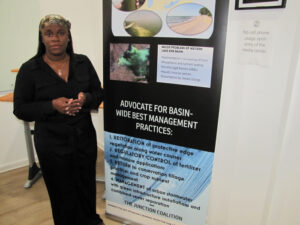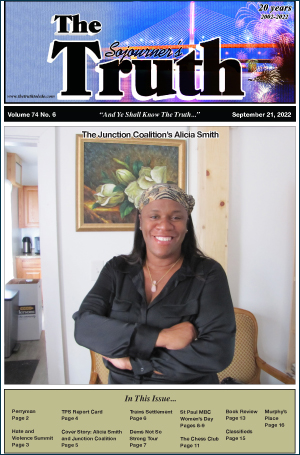 By Fletcher Word
By Fletcher Word
Sojourner’s Truth Editor
In 2016, the Center for Community Progress prepared an Open Space Action Plan for the Junction neighborhood. The report noted, among other factors, that the Junction community, a neighborhood of 4,700 land parcels, had “a staggering vacancy rate of 45 percent” and that “54 percent of residents live in poverty.”
Given the all-encompassing poverty and the dwindling population of the Junction neighborhood, it would not be surprising if efforts to turn the situation around had all but ended in fits of frustration. Such is not the case. The area is the focus of so many dedicated groups and individuals striving to make a difference in the lives of the residents.
The recent groundbreaking for two new houses on Belmont Street is a case in point. The Maumee Valley Habitat for Humanity is the point organization on those structures and has plans to build an additional 13 houses in the City Park/Collingwood Corridor of the Junction neighborhood.
According to Michael McIntyre, executive director for Habitat for Humanity of Maumee, Alicia Smith, community liaison for the Junction Coalition, invited his organization to extend their work in home renovation and building in the Junction area. Habitat joined with funding partners such as Owens Corning, ProMedica Junction, Greater Toledo Community Foundation, the City of Toledo, the Lucas County Land Bank and the Toledo Design Collective, among others, to put the money together for the new construction.
The roots for the Junction Coalition were planted in 2012 when funding for the inner-city neighborhood from ESOP (Empowering and Strengthening Ohio’s People) dried up and community leaders decided to take matters into their own hands.
The neighborhood, bordered by Dorr Street, on the north, to Klondike and from I-75on the east, to Brown Street sits within the former ONYX community Development Corporation (CDC) which is no longer a resource for the community.
Director Smith, she prefers the “community liaison” title rather than the director label because she insists that she is a voice for the needs and desires of the community, began her work with the Junction Coalition in 2012 as the community took on a smattering of activities in the wake of that loss of outside funding – caring for elders, cutting grass, clearing spaces.
In 2014, when the algae bloom outbreak took place, the Coalition undertook bigger challenges and started dealing with public health issues – particularly because of the lead and asthma concerns that plague inner city communities – “issues of environmental justice and equality,” says Smith.
The mission of the Junction Coalition became one of providing a viable voice for neighbors and cultivating healthy relationships while working to combat the blight of vacant lots and abandoned homes.
The Coalition focuses on four pillars that are essential to achieving its goals, says Smith. Those are as she describes them:
“Social Justice, which is the social impact of the individuals that live in the Junction;
“Economic Justice to ensure community wealth and the reduction of generational poverty;

“Environmental Justice which ensures the health and wellness of our earth, ourselves and our futures by way of clean air, clean energy, clean and affordable water making sure that there are green infrastructures for the reduction of our urban heat island;
“Peace Education – we’ve always heard everything about war. Never do we hear about peace. People of color have been known throughout our history to induce peace through music, art and culture – so peace education is a large part of all those things.
“Each pillar is interconnected, there’s intersectionality. You can’t have one without the others.”
Several years ago, the Junction Coalition moved into their headquarters at, appropriately enough, 419 Junction Street. The Coalition has formed six departments under its umbrella.
The housing department, under the guidance of Eunice Glover, is “focused on making sure that low-to-moderate income families understand Homeownership, housing sustainability while also ensuring our families have the support they need from the banks,” says Smith. “It’s about equity and building community wealth.”
The Junction Economic Transformation (J.E.T.), Ocie Irons’ department, focuses on small businesses and, especially, helping owners working out of their homes to come out of their houses and use the building’s facilities, on the second floor, as office space to contact and meet with their clients.
Also on the second floor of 49 Junction, is the podcast center – Urban Narrative Expression – where the Coalition “provides voice to our youth,” says Smith. The podcast is streamed over YouTube.
Environmental justice is in the hands of Smith herself and her assistance Marya Czech. “We try to ensure that we have education around water, air and soil issues. As Smith notes, “we have a host of issues around algae,” attributable to the fact that pollution continues and there is not enough regulation.
“Safe and affordable water” has been the mantra of the Coalition even before the 2014 water crisis.
The restorative justice program is under the guidance of David Ross and the youth coordinator is Derrick Austin who strives to get youth out of juvenile court and helps the high-risk population/youth get into the J.O.Y. program (Jobs, Opportunity, Youth).
The Coalition’s task is first and foremost, explains Smith, an effort to focus on the business opportunities.
“If you look at the Junction community, you have a Mecca,” says Smith. “It is a business district. That’s what the vision of the Junction Coalition was. Any smart economic driver is going to look at where does the city indicate the money is supposed to be?”
There are currently 66 black-owned businesses in the neighborhood, according to Smith’s count and they will thrive if the neighborhood’s population can grow, if homeownership can expand and if generational wealth can be built.

